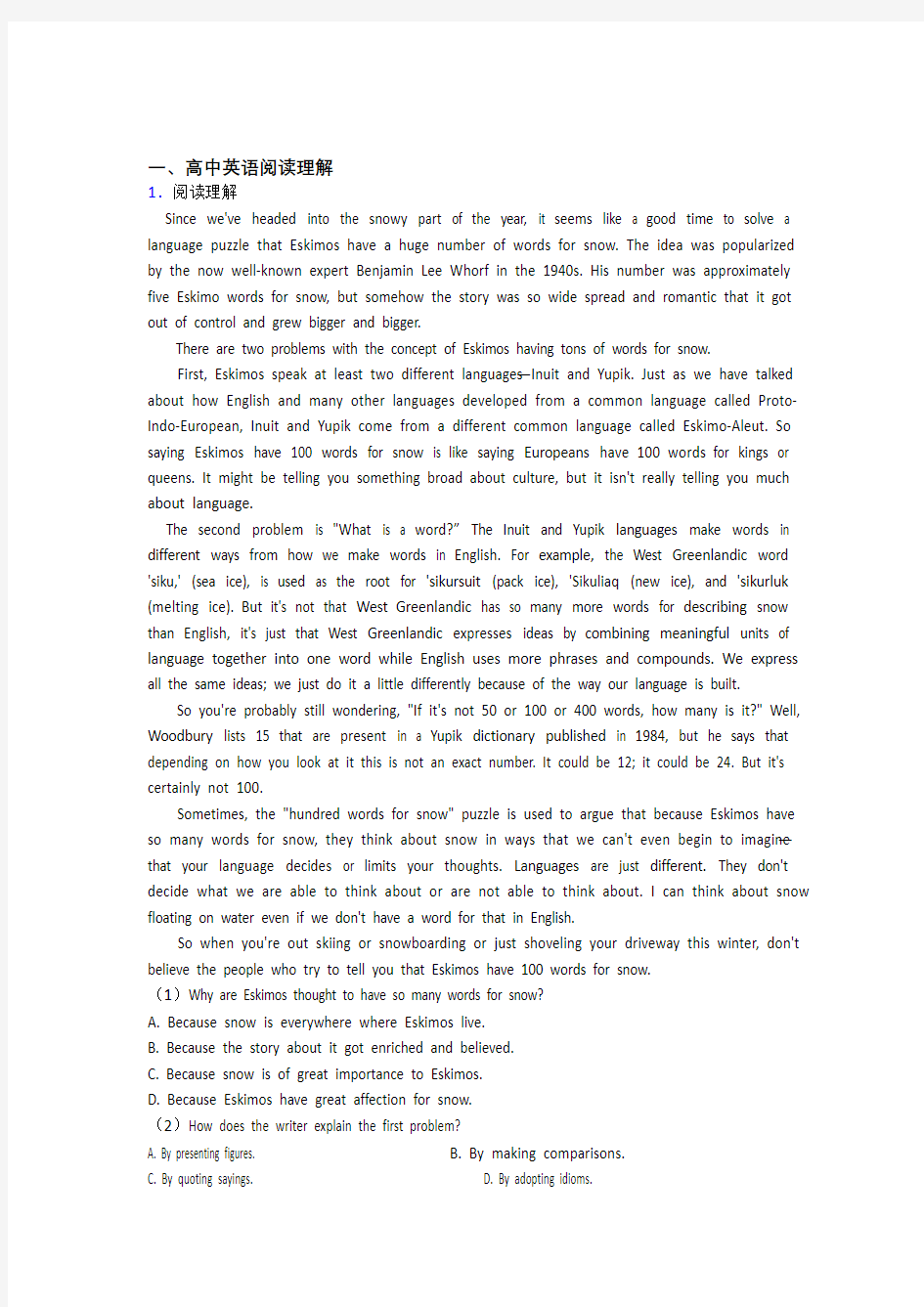高中英语阅读理解经典试题(含答案) 百度文库

- 1、下载文档前请自行甄别文档内容的完整性,平台不提供额外的编辑、内容补充、找答案等附加服务。
- 2、"仅部分预览"的文档,不可在线预览部分如存在完整性等问题,可反馈申请退款(可完整预览的文档不适用该条件!)。
- 3、如文档侵犯您的权益,请联系客服反馈,我们会尽快为您处理(人工客服工作时间:9:00-18:30)。
一、高中英语阅读理解
1.阅读理解
Since we've headed into the snowy part of the year, it seems like a good time to solve a language puzzle that Eskimos have a huge number of words for snow. The idea was popularized by the now well-known expert Benjamin Lee Whorf in the 1940s. His number was approximately five Eskimo words for snow, but somehow the story was so wide spread and romantic that it got out of control and grew bigger and bigger.
There are two problems with the concept of Eskimos having tons of words for snow.
First, Eskimos speak at least two different languages—Inuit and Yupik. Just as we have talked about how English and many other languages developed from a common language called Proto-Indo-European, Inuit and Yupik come from a different common language called Eskimo-Aleut. So saying Eskimos have 100 words for snow is like saying Europeans have 100 words for kings or queens. It might be telling you something broad about culture, but it isn't really telling you much about language.
The second problem is "What is a word?” The Inuit and Yupik languages make words in different ways from how we make words in English. For example, the West Greenlandic word 'siku,' (sea ice), is used as the root for 'sikursuit (pack ice), 'Sikuliaq (new ice), and 'sikurluk (melting ice). But it's not that West Greenlandic has so many more words for describing snow than English, it's just that West Greenlandic expresses ideas by combining meaningful units of language together into one word while English uses more phrases and compounds. We express all the same ideas; we just do it a little differently because of the way our language is built.
So you're probably still wondering, "If it's not 50 or 100 or 400 words, how many is it?" Well, Woodbury lists 15 that are present in a Yupik dictionary published in 1984, but he says that depending on how you look at it this is not an exact number. It could be 12; it could be 24. But it's certainly not 100.
Sometimes, the "hundred words for snow" puzzle is used to argue that because Eskimos have so many words for snow, they think about snow in ways that we can't even begin to imagine—that your language decides or limits your thoughts. Languages are just different. They don't decide what we are able to think about or are not able to think about. I can think about snow floating on water even if we don't have a word for that in English.
So when you're out skiing or snowboarding or just shoveling your driveway this winter, don't believe the people who try to tell you that Eskimos have 100 words for snow.
(1)Why are Eskimos thought to have so many words for snow?
A. Because snow is everywhere where Eskimos live.
B. Because the story about it got enriched and believed.
C. Because snow is of great importance to Eskimos.
D. Because Eskimos have great affection for snow.
(2)How does the writer explain the first problem?
A. By presenting figures.
B. By making comparisons.
C. By quoting sayings.
D. By adopting idioms.
